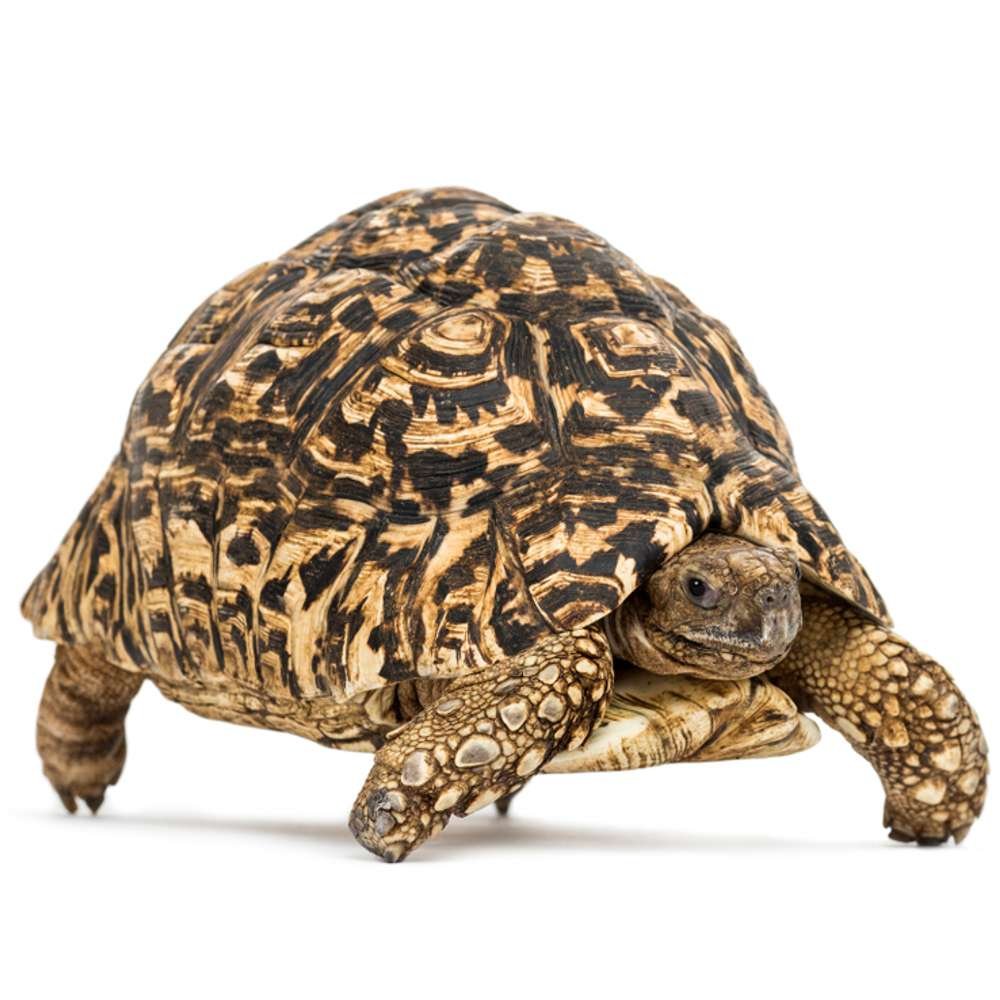Leopard Tortoise
- Stigmochelys pardalis
- IUCN Status: Least Concern
- Threat: harmless
- Venom/Toxin: none
- Trend: decreasing

- Phylum: Chordata
- Class: Reptilia
- Order: Testudines
- Suborder: Cryptodira
- Family: Testudinidae
- Genus: Stigmochelys
Share:
General Information
All tortoises are actually turtles, as they all belong to the order of Testudines, but not all turtles are tortoises! The leopard tortoise is a large tortoise and it has a very attractive shell which has leopard style patterns that fade the older and larger they grow.
Fun Facts!
The leopard tortoise is the fourth-largest species of tortoise in the world. Turtles and Tortoises are known to be highly intelligent. They can dig under or plan their escape from captivity, they can learn new tricks and remember them for a very long time. Another interesting feature is that they have both an exoskeleton (the shell on the outside) and an endoskeleton (the bones on the inside).
Description
It is a large and attractively marked tortoise. The carapace (top part of the shell) is high and domed with steep, almost vertical sides. Juveniles and young adults are attractively marked with black blotches, spots, or even dashes and stripes on a yellow background. In mature adults, the markings tend to fade to a nondescript brown or grey. The head and limbs are uniformly colored yellow, tan, or brown.
- Length: up to 70 cm
- Weight: up to 40 kg
- Lifespan: up to 100 yrs
Ecology and Behaviour
The Leopard tortoises are normally active during the day, they are less active during hot weather or during the dry season. Seeds can pass undigested through the gut, so the leopard tortoise plays a significant role in seed dispersal.
Diet
Leopard tortoises are herbivores and feed on forbs, thistles, grasses, plants, leaves and succulents. They may also gnaw on bones and eat hyena feces to obtain calcium.
Reproduction
The leopard tortoise reaches sexual maturity between 12 and 15 years old.During the mating season, males fight over females, ramming and butting their competitors. They trail after females for quite some distance, often ramming them into submission. When mating, the male makes grunting vocalizations. Nesting occurs between May and October when the female digs a hole and lays a clutch of five to 30 eggs. As many as five to seven clutches may be laid in a single season. Incubation takes 8–15 months depending on temperature. The numerous predators of the eggs and hatchlings include monitor lizards, snakes, jackals, and crows. Adults have few natural predators, but lions and hyenas have occasionally been reported preying on them
Conservation
It is categorized by the International Union for Conservation of Nature (IUCN) as, ” Least Concern “.
Distribution and Habitat
The leopard tortoise occupies the most varied habitats of any African tortoise. They can be found in grasslands, thorn-scrub, mesic brushland, savannas and even altitudes ranging from sea level to 2,900 m
Interaction with humans
Currently it is mainly threatened by widespread collection from the wild for the illegal international trade in the species. It is also collected by local peoples for food and human population growth in the area is putting pressure on the species. Human-induced fire is also a threat. In most Zambian cultures, turtles and tortoises are revered and respected by people. It is said that one should never kill a turtle or tortoise without reason. If you are to come across one stuck upside down along your path, it is said to be good luck to help it and turn it over to let it goon its way and that doing the opposite or leaving it stuck is very bad luck and karma.
No donation to this project yet.
| M | T | W | T | F | S | S |
|---|---|---|---|---|---|---|
| 1 | 2 | 3 | 4 | 5 | 6 | 7 |
| 8 | 9 | 10 | 11 | 12 | 13 | 14 |
| 15 | 16 | 17 | 18 | 19 | 20 | 21 |
| 22 | 23 | 24 | 25 | 26 | 27 | 28 |
| 29 | 30 | 31 | ||||


